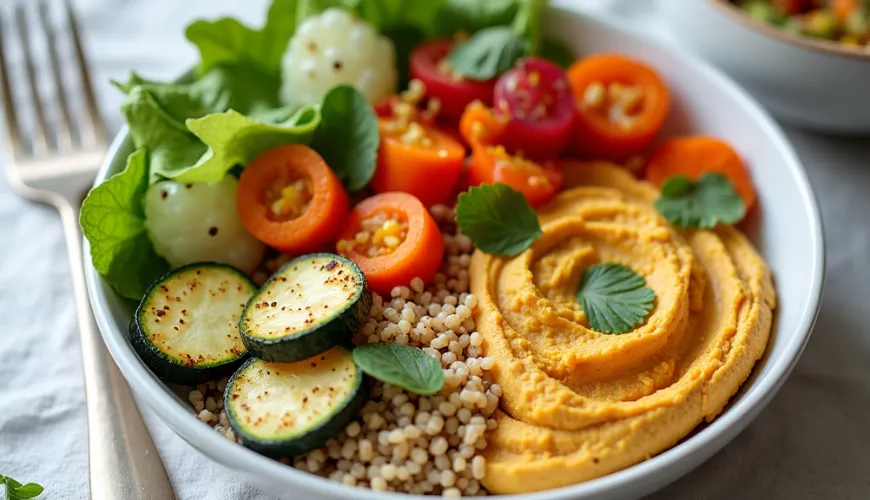
Are you interested in what to eat with hummus? Get inspired by our ideas

Hummus - What to Eat It With So It Never Gets Boring
Hummus – a creamy spread made from chickpeas, tahini, and lemon – has long found its way from the Middle East to European refrigerators and cafes. It has become an indispensable part of a healthy diet and is favored by vegetarians, vegans, and lovers of Mediterranean cuisine. But even though hummus is delicious and nutritious on its own, the question often arises: what should you eat hummus with so it's not always the same thing?
We will take a closer look at this question and show you how to make hummus a universal base for breakfast, snacks, and main courses. Whether you're a kitchen experimenter or a die-hard classicist, you're sure to find a way that excites you.
The Classic That Never Disappoints – With Fresh Bread and Vegetables
One of the simplest and at the same time most popular ways, what to eat hummus with, is to pair it with bread. Arabic pita bread, crispy baguettes, rye toasts, or even homemade sourdough bread – these are all great partners for this spread. Fresh bread can complement hummus in both flavor and texture: soft cream versus crunchy crust is a combination that always works.
Another staple is fresh vegetable sticks – carrots, bell peppers, cucumbers, celery, or radishes. Not only do they add crunchiness and freshness to hummus, but they also elevate it to an even healthier level. It's an ideal snack for work or a light dinner that fills you up without weighing you down.
Take, for example, a typical day at the office. Instead of a classic sandwich or a cookie with your afternoon coffee, you can prepare a box with hummus, sliced carrots, bell peppers, and a few olives. It's tasty, quick, and also hearty. And your colleagues might start asking what delicious thing you have.
Hummus as a Main Course? Definitely Yes
Less common, but all the more interesting use of hummus is as part of a larger, wholesome meal. It can easily be incorporated into warm cuisine. One popular recipe is hummus as a base for a "bowl" – a bowl full of nutritious ingredients.
Simply add cooked quinoa or bulgur, roasted vegetables (such as sweet potatoes, zucchini, broccoli), a few salad leaves, pickled red onion, sesame seeds, and crown it all with several tablespoons of hummus. The result is a dish that not only looks great but also tastes excellent and is full of nutrients.
Another way, what to eat hummus with, is as a complement to roasted meats or grilled tofu. Its mild flavor beautifully balances spicy dishes, similar to yogurt or sour cream, but without animal products. It is excellent with spicy falafels or as a "sauce" for roasted eggplant.
Inspiration from Our Neighbors' Kitchens – Unusual Combinations
If you’re not afraid to experiment, you can combine hummus with flavors that might not immediately come to mind. For example, hummus with sauerkraut or kimchi can be a surprisingly delightful experience, especially if you love fermented foods. The acidity and spiciness of fermented products contrast with the creamy texture of hummus, creating an interesting flavor dynamic.
Another intriguing choice is hummus on toast with a poached egg – a protein bomb that can kickstart the whole day. And how about hummus instead of butter under avocado? The combination of healthy fats, fiber, and plant-based proteins makes sense not only nutritionally but also in terms of taste.
"Hummus is like a canvas on which everyone can paint their own flavor palette," says Israeli-Spanish chef Renana Shvil, who works with it in restaurants across Europe. It is precisely because of this versatility that hummus has earned its place on tables across cultures.
Sweet? Why Not
Although hummus is usually savory, there are sweet versions as well. These use the basic structure of chickpea paste but are flavored with cocoa, cinnamon, maple syrup, or vanilla. Sweet hummus is then suitable as a healthy alternative to chocolate spreads – for example, on banana bread or as a dip for apples.
Even though sweet hummus is not yet a common part of shelves in our country, it has become a regular item in health food stores in the USA in recent years. And why not – if you can make cookies or a cake from chickpeas, why not sweet hummus too?
Tips to Elevate Hummus to a New Level
Finally, here are some practical tips on how to not only eat hummus but also enhance it so it never gets boring:
- Add herbs or spices: fresh coriander, parsley, smoked paprika, turmeric, or cumin will give hummus a new dimension.
- Try seasonal vegetables: roasted pumpkin, beets, or grilled peppers transform ordinary hummus into a gourmet experience.
- Use it as a spread and a dressing: with a little water or lemon, you can dilute it and use it as a sauce for salads or wraps.
- Serve it with Lebanese side dishes: such as baba ghanouj (eggplant spread), tabbouleh, or olives – you’ll create a homemade mezze plate like from a restaurant.
One thing is certain – hummus is exceptionally versatile. Whether you serve it with bread, vegetables, as part of a salad, or as the base for a main dish, it always manages to surprise. Moreover, it is rich in fiber, plant-based proteins, and healthy fats, making it an ideal choice for anyone looking for a tasty and nutritious alternative to regular spreads.
So what to eat hummus with? There are so many options that it's not really a question – but an invitation to explore.

